Stebuklingas pulkininko leitenanto Eduardo Graudinio pabėgimas nuo sušaudymo
1944 m. lapkritį vokiečių okupacinės valdžios karo lauko teismas nuteisė 8 generolo Kurelio grupės štabo karininkus, trys štabo karininkai dėl įvairių priežasčių buvo atleisti. Pulkininkui leitenantui pavyko pabėgti nuo sušaudymo, bet Graudinį „trypė“ Vokietijos koncentracijos stovyklų sistema.
Naktį iš 1944 m. lapkričio 19 d. į 20 d. Liepojos Karostos kalėjime vyko vokiečių okupacinės valdžios karo lauko teismas, kuriame buvo nuteisti mirti aštuoni generolo Kurelio grupės štabo karininkai, trys štabo karininkai dėl įvairių priežasčių buvo atleisti.
Pulkininkas leitenantas Eduardas Graudinas buvo vedęs baltą vokietę ir susilaukė dviejų vaikų – sūnaus ir dukters. Dešimtojo dešimtmečio pabaigoje jis išsiskyrė, o buvusi žmona ir jųdviejų vaikai 1939 m. emigravo į Vokietiją. Sūnus buvo pašauktas į Vokietijos ginkluotąsias pajėgas ir tarnavo elitinėje „Grossdeutschland“ divizijoje. 1944 m. vasaros pabaigoje jis buvo nužudytas. Kai vyko teismas, buvusi žmona parašė malonės prašymą dėl sūnaus tarnybos. Eduardas Graudinas buvo išsiųstas į Štuthofo koncentracijos stovyklą ir mirė 1945 m. vasarį, kai ji buvo evakuota.
GRAUDINAS EDUARDAS Petro sūnus
Nepriklausomybės kuopos kapitonas. Latvijos Lenkijos ginkluotųjų pajėgų ordino (LKOK) Latvijos ordino Riterių ordino Latvijos Riterių ordino Latvijos Riterių ordino ordino kavalierius
Latvijos legiono ordinas „Už nuopelnus“, suteiktas 1921 m
Pulkininkas leitenantas Eduards Graudiņš: Nepriklausomybės karas, Latvijos valstybė, Štuthofo koncentracijos stovyklos | Sargs.lv
https://www.sargs.lv/lv/vienibas-un-personibas/2011-02-17/pulkvedis-leitnants-eduards-graudins-neatkaribas-kars-latvijas
LKOK nr.3/878: Graudiņš, Eduards www.lkok.com/detail1.asp?ID=476
Jūsų komentarai
Dėkojame už jūsų informaciją. Šią informaciją parengė istorikai, galbūt jie turėjo kokių nors dokumentų, patvirtinančių tai, kas parašyta tekste.
Susijusi laiko juosta
Susijusios vietos
The place where General Kurelis's staff officers were shot
At the end of July 1944, when the Red Army invaded the territory of Latvia, the German occupation authorities allowed Jānis Veide, the Riga District Police Chief and Commander of the 5th Riga Guards Regiment of the restored Latvian Guards Organisation, to establish the "General Kurelis Group of the Riga Guards Regiment". The head of the Military Commission of the Central Council of Latvia, General Jānis Kurelis of the Latvian Army, became its leader.
The Kurelis operated in Vidzeme until September 1944, when they moved to Kurzeme, where they were stationed in the houses of Stiklis in Puzes parish, Ilziķi in Usma parish, Iliņi in Ģibuli parish, and in Edole and other places in Northern Kurzeme. By the end of October 1944, the Kurelies had about 3,000 armed men, among them many former soldiers of the Latvian SS Volunteer Legion units, who joined the unit to realise their dream - the fight for Latvia's independence.
At the beginning of November 1944, the German occupation authorities' Supreme Police and SS leader in Ostland, SS Oberruppenführer Friedrich Jeckeln, began to restrict the group's activities and on 14 November arrested the Kurelian headquarters and more than 700 soldiers in Stikliai, Puse parish. The battalion commanded by Lieutenant Robert Rubens, with about 500 men in the Usma area, resisted and continued fighting until December 1944.
On the night of 19/20/1944, the Germans fought against the Germans. On November 19-19, 1944, a court-martial of the German occupation authorities was held in Liepāja Karaostas Prison, sentencing to death eight staff officers of General Kurelis' group - Colonel Pēteris Liepiņš, Captain Kristaps Upelnieks, Captain Jūlijs Mucenieks, Lieutenant Jānis Gregoras, Lieutenant Teodorma Prikulis, Lieutenant Jānis Rasas, Lieutenant Filipson and Adjutant Kārlis Valters. Three staff officers, Lieutenant Colonel Eduards Graudins, Lieutenant Arthurs Ankravs and Sergeant Vili Pavulāns, were pardoned for various reasons. On the afternoon of 20 November, the convicts were shot in the dunes near the Karosta prison, where a white cross can be seen today.
In 1994, a memorial to the officers who were shot was established in the dunes of the Liepaja Karosta. In 2012, after it was washed into the sea, the memorial was restored to its present location.
*** Translated with www.DeepL.com/Translator (free version) ***
Kurelian headquarters in Stiklos
During the Second World War in 1944, the Kurelian headquarters was located in the Annahite hunting castle in Stiklos. This building has survived to this day.
The surroundings of Stikli are rich not only with swamps and forests, but also with sand. In 1897, the new Annahites glass factory started its work - that's how this Latvian settlement got its name Stikli. In 1900, the so-called Annahite hunting palace, or the building where the factory manager lived, was built right there on the shore of Lake Stiklos.
The site of the battle of the Ruben battalion on November 18, 1944, near Pērkoni's house
A memorial site at the site of the November-December 1944 battles of Lieutenant R. Ruben's battalion between the houses of "Vēvera" and "Dzilna" in Ugāle parish.
"Robežu" houses in Skriveri parish
In the house of "Robežu" in Skriveri Parish is the place where the formation of the group of General J. Kurelis started on July 28, 1944.
Memorial stone for Kurele people in Skriveri Parish
Piemiņas akmens kureliešiem netālu no “Robežu” mājām Skrīveru pagastā, atklāts 2015. gadā.
Strazde manor
The Strazde manor is located on the side of the Riga - Ventspils highway and it was the location of the group of General J. Kurelis on September 29 - October 28, 1944.
Heavily rebuilt to meet the needs of the school (from 1922), it lost its original appearance and proportions during the rebuilding. Strazde Manor is surrounded by a beautiful park.
Yekeln's headquarters in Talso
On November 3, 1944, General J. Kurelis and Captain K. Upelnieks held talks with SS Obergrupenführer F. Yekeln and other German officers in this building in Talso. The historic building has been demolished, a new building is being built in its place.
Former shop/police building
The former store/police building in Talsos, where 14-19 of 1944 in November, the headquarters officers of General J. Kurelis' group were imprisoned.
A memorial stone for the people of Kurele in Stiklo
A memorial stone for Kurele people near Annahite hunting castle "Stiklos" in Puze parish, discovered in 1997, moved in 2023.
There is an information board with a QR code near the stone, where there is an audio guide's narration about the Kurelians.
Memorial site in the old Annahite Cemetery
Memorial place in the old Annahite cemetery, where the soldiers and civilians killed on November 14, 1944 as a result of the headquarters and main forces of the German besieging general J. Kurelis group are buried.
Memorials to the group of General J. Kurelis and Lieutenant R. Ruben in the "Dzelzkalnu" cemetery
Memorial stones for the group of General J. Kurelis and Lieutenant R. Rubenis in the "Dzelzkalnu" cemetery in Puze parish. Opened in 1997.
The memorial signs were installed even before the creation of the Rubenis Battalion Museum.
The place of collision near Chubu's house in Renda parish
The clash of the 2nd company of Lieutenant L. Znutenas of the battalion of Senior Lieutenant V. Strautnieks with the Germans took place on November 16, 1944.
The white cross and the place of execution in Karosta
The white cross and the place of execution in front of Liepāja's Karosta prison. Opened in 2000.
Graves of soldiers of Ruben's battalion
The graves of soldiers of Ruben's battalion are located by the highway Kuldīga - Sabile. A road sign and a stone with the inscription "For Your Land and Freedom" are located just a few hundred meters from the road.
The battalion of Lieutenant Robert Rubenis was one of the parts of the military unit formed by General Jānis Kurelis, which did not surrender to the German troops and showed fierce German resistance. During the Usma period, the numerical composition of the battalion increased to 650 men with four fully equipped companies, an ambulance and a farm team. Commanding staff: lieutenant R. Rubenis, lieutenant Filipsons, vv A. Druviņš, vv Šults, vv Briedis, vv. sergeant J. Rubenis, J. Bergs, vv Jaunzems.
From November 14 to December 9, 1944, fierce battles took place in the parishes of Ugāle, Usma, Renda and Zlēki between units of the German 16th Army, SD and SS units under the command of police general Friedrich Jekeln and a separate battalion of the Kurelian unit commanded by lieutenant Roberts Rubenis. Around 250 German soldiers were killed in the battles near Renda and Zleki, while the losses of the Rubenes were around 50 people.
After the death of Lieutenant Rubenis, Druviņš announced to his men that he would continue to work on a voluntary basis and as a result, several dozen men made the decision to separate from Rubenis' battalion. On November 20-21, 1944, a group of 11 people was captured by a German SD unit and after interrogations they took them to the local forest and shot them.
The site of the battles of Ruben's battalion on November 18, 1944
Memorial place at the site of the battles of Lieutenant R. Rubeņas' battalion on November 18, 1944, between the houses of "Pērkon" and "Mežzīļu" in Renda parish.




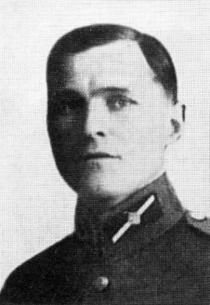

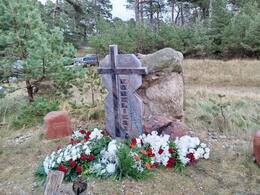
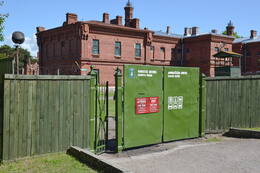
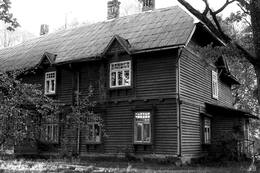
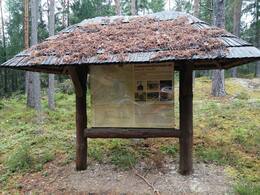
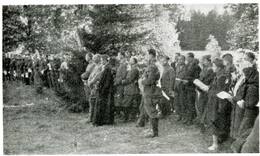
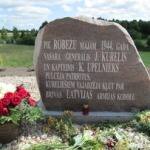


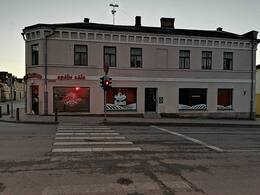
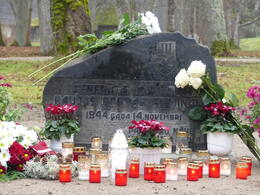
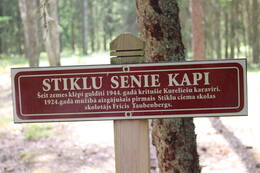

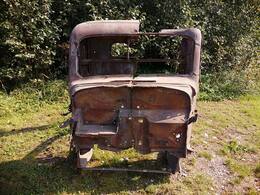
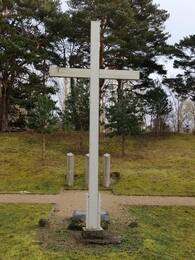
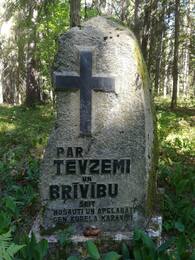
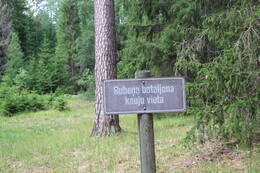
Dalis to yra mitas. Esu Eduardo anūkė iš antrosios santuokos. Pirmoji jo žmona turėjo dvi dukteris ir sūnų, kuris žuvo vokiečių tankų divizijoje, jam tuo metu buvo apie 17 metų. Jo pirmoji žmona niekaip negalėjo girdėti apie karo teismą, juo labiau dalyvauti ar įteikti laišką, nes ji buvo Lenkijoje. „Karo teismas“ (kuris buvo akivaizdžiai neteisėtas, nes kureliečiai nebuvo Vokietijos armijos dalis) buvo pasala. Jis buvo suimtas per „susitikimą“, o kitą dieną buvo teisiamas ir nuteistas. Turime laiškų, kuriuos jis rašė iš kalėjimo prieš ir po „teismo“. Jis susilaukė 3 vaikų su savo antrąja žmona, kuri teismo metu buvo netoli Talsų, sekė į Štuthofą, bet negalėjo su juo susisiekti. Ji persikėlė į Australiją. Pirmosios žmonos šeima persikėlė į Ameriką. Nežinome, kodėl teismo metu jis nebuvo nušautas, bet laiško nebuvo.